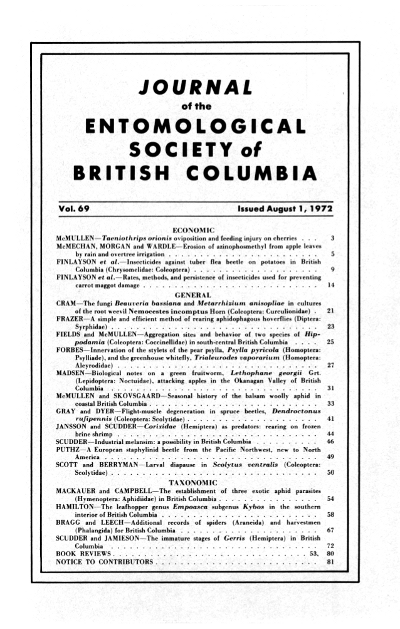Rates, methods and persistence of insecticides for preventing carrot maggot damag
Abstract
Fourteen carbamate and organophosphorus insecticides for preventing damage by carrot maggot, <i>Psila rosae</i> (Fab.), were applied as granules in the seed furrow at 2 locations in muck soil, and supplemented with 2, 3, 4, or 8 sprays of the same materials during the season. The spray applications were made at 40 and 70 days after seeding; 30, 50, and 70 days; 30, 50, 70, and 90 days; 40,70, and 100 days. Diazinon, the currently recommended treatment, was applied 8 times at lO-day intervals from 30 to 1OO days. All the granules except chlorfenvinfos and ethion reduced the number of emergent seedlings. The reduction was 40% in plots treated with diazinon, thionazin, Chemagro 7375, Nemacur, pirimiphos-methyl, and TD-8550. Maggot damage was negligible until 100 days after seeding, but by 160 days only plots treated with carbofuran, fensulfothion, ethion and 3 of the numhered compounds had less than 20% damage. Residues of pesticides in the carrots ranged from 0.12 ppm of ethion 30 days after the final application, to 1.28 ppm of thionazin 10 days after. Residues in carrots held in storage at 5∞C for 30, 60, and 90 days, increased with the period of storage, except those from plots treated with chlorfenvinphos.References
Cook, R.F., H.P. Stanovick, and C.C. Cassil. 1969. Determination of carbofuran and its carbamate metabolite residues in corn using a nitrogen-specific gas chromatographic detector. J. Agr. Food Chem. 17:277-282.
Ridwell, C.L. and W.F. Sterling. 1925. Preliminary notes on the direct determination of moisture. Ind. Eng. Chem. 17:147-149.
Coulson, D. M. 1966. Selective detection of nitrogen compounds in electrolytic conductivity gas chromatography. J. Gas Chromatogr. 4:285-287.
Finlayson, D.G., H.C. Fulton, and I.H. Williams. 1970. Fensulfothion and thionazin residues in carrots. J. Econ. Entomol. 63:1304-1306.
Finlayson, D.G., H.C. Fulton, and M.D. Noble. 1964. Experiments against carrot rust fly, Psila rosae (F )) resistant to cyclodiene organochlorine insecticides. Proc. Entomol. Soc. Brit. Columbia 61:13-20.
Finlayson, D.G., H.C. Fulton, and M.D. Nohle. 1966. Integrated control of cyclodiene-resistant carrot rust f1y. J. Econ. Entomol. 59:1082-1085.
Finlayson, D.G., I.H. Williams and H.C. Fulton. 1968. Residues of diazinon in carrots after treatment against cyclodiene-resistant carrot rust fly. J. Econ. Entomol. 61:1174-1176
Kenaga, E.E. and W.E. Allison. 1969. Commercial and experimental organic insecticides. Bull. Ent. Soc. America. 15:85-148.
Storherr, R.W. and R.R. Watts. 1965. A sweep co-distillation cleanup method for organophos-phate pesticides. I Recoveries from fortified crops. J. Assoc. Offic. Agr. Chem. 48:1154-1158.
Suett, D.L. 1971. Persistence and degradation of chlorfenvinphos, diazinon, fonofos and phorate in soils and their intake by carrots. Pestic. Sci. 2:105-112.
Watts, H.H. and R.W. Storherr. 1965. A sweep co-distillation cleanup method for organophosphate pesticides. II Rapid extraction method for crops. J. Assoc. Offic. Agr. Chem. 48:1158-1160.
Wheatley, G.A. 1971. Pest control in vegetables: some further limitations in insecticides for cabbage root fly and carrot fly control. Proc. 6th Br. Insectic. Fungic. Conf. pp. 386-395.
Williams, I.H., R. Kore, and D.G. Finlayson. 1971. Determination of residues of Dasanit and three metabolites by gas chromatography with flame photometric detection. J. Agr. Food Chem. 19:456-458.
Downloads
Published
Issue
Section
License
Authors who publish with the Journal of the Entomological Society of British Columbia agree to the following terms:
-Authors retain copyright and grant the journal right of first publication with the work simultaneously licensed under a Creative Commons Attribution License that allows others to share the work with an acknowledgement of the work's authorship and initial publication in this journal.
-Authors are able to enter into separate, additional contractual arrangements for the non-exclusive distribution of the journal's published version of the work (e.g., post it to an institutional repository or publish it in a book), with an acknowledgement of its initial publication in this journal.
-Authors are permitted and encouraged to post their work online (e.g., in institutional repositories or on their website) prior to and during the submission process, as it can lead to productive exchanges, as well as earlier and greater citation of published work (See The Effect of Open Access).


